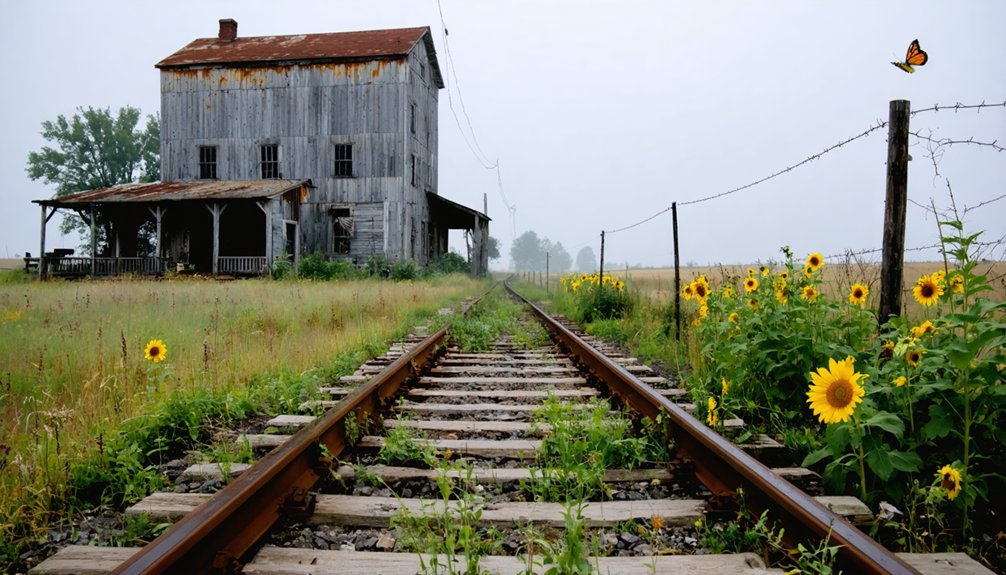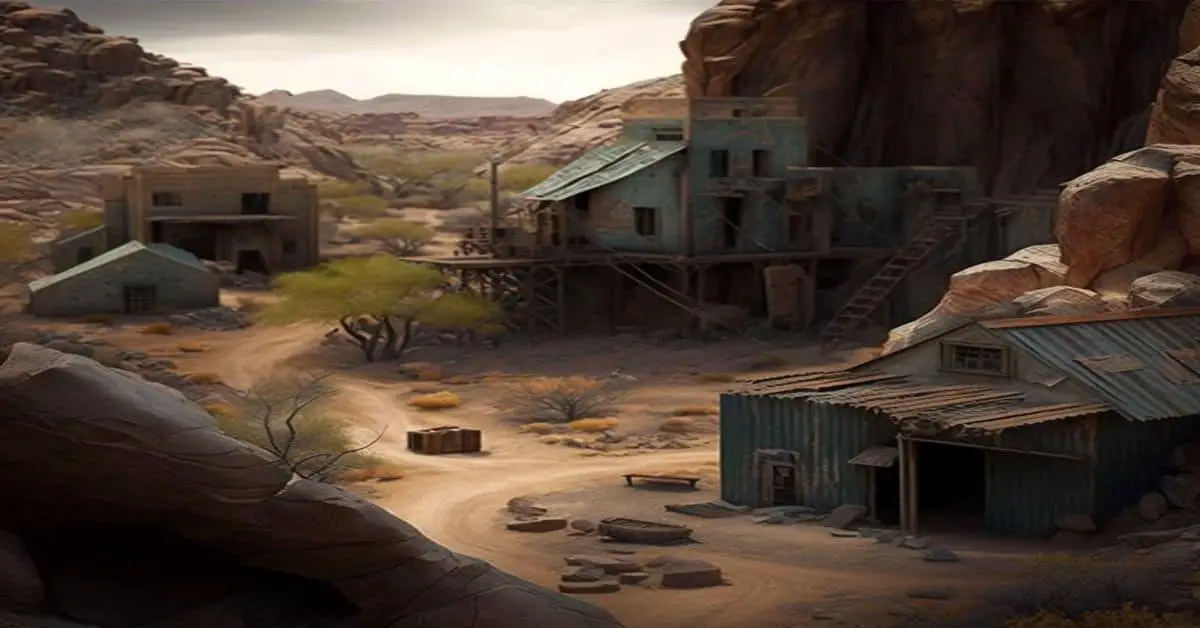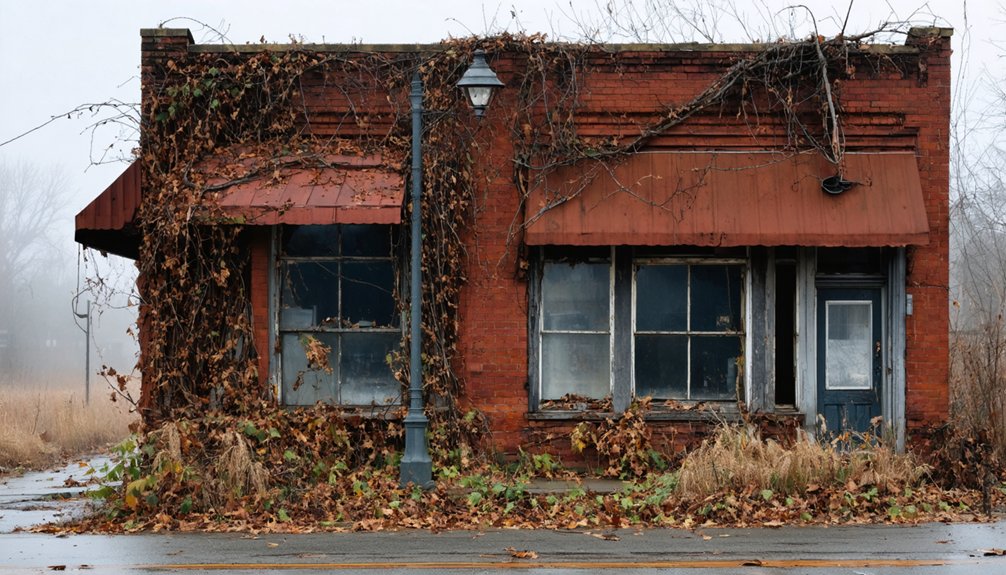You’ll find Corwin, Indiana, along the historic Lafayette rail line in Randolph Township, Tippecanoe County. Established in 1856 by Cyrus Foltz, this small settlement began with seven lots and high hopes for growth. Despite its prime railroad location and fertile farmland, Corwin couldn’t compete with larger nearby towns. Today, you can spot remnants of its past through a modernized house, cemetery stones, and a basement room that once served the Underground Railroad. The town’s untold stories lie beneath its reclaimed landscape.
Key Takeaways
- Established in 1856 along the Lafayette rail line, Corwin failed to thrive despite favorable location and eventually became a ghost town.
- Only seven original lots were laid out by founder Cyrus Foltz, but competition from larger nearby towns hindered development.
- Today, just one modernized house remains on the site, while other structures like barns and the salt house are demolished.
- The town’s location at 40°15’6″N and 86°54’54″W in Randolph Township contains archaeological evidence of its past settlement.
- A basement room used for Underground Railroad activities survives, while nature has reclaimed most structural foundations.
The Rise and Fall of a Railroad Settlement
While railroads transformed much of Indiana’s landscape in the mid-19th century, the small settlement of Corwin emerged as a modest venture along the Lafayette rail line in 1856.
You’ll find that Cyrus Foltz laid out just seven lots, hoping the railroad influence would spark growth and prosperity in this new community.
Despite the promising location and the era’s settlement patterns favoring railroad towns, Corwin never flourished as expected. The state fund commissioners had supported many successful railroad projects throughout Indiana.
Not every railroad town was destined for success, as Corwin proved despite its advantageous position along the tracks.
While other Indiana communities thrived with the arrival of rail transportation, bringing economic opportunities and increased population, Corwin remained stunted in its development. Lake County’s three major cities emerged as proof of railroad-driven success.
The settlement’s limited infrastructure and fierce competition from larger nearby towns contributed to its eventual decline.
Today, Corwin stands as a reflection of the uneven impact of railroad development across Indiana’s frontier communities.
Geographic Features and Town Layout
Nestled in Randolph Township of Tippecanoe County, Indiana, Corwin occupied a strategic position at coordinates 40°15’6″N and 86°54’54″W. At an elevation of 2,411 feet, you’ll find this ghost town set against Indiana’s characteristic flat to rolling terrain, surrounded by fertile farmland.
The town’s settlement patterns followed typical rural infrastructure of the era, with roads named after early pioneers like Sleeper Road creating a basic grid layout. Originally established in 1856 near Monon, the town was laid out with seven lots along the railway line.
You can still trace Corwin’s footprint through surviving landmarks, including the nearby Farmer’s Institute (formerly a Quaker meeting house) and scattered cemetery stones. Like the town of Anita, a roadside plaque commemorates Corwin’s historical significance.
While most original structures have vanished, the town once featured essential buildings like houses, stores, and a blacksmith shop in the adjacent “Little Chicago” area, forming a modest but self-sufficient community hub.
Agricultural Heritage and Economic Life
Throughout Corwin’s heyday, agriculture formed the backbone of local economic life, with farms typically ranging from 70 to 400 acres of mixed-use land.
Local physician Joseph H. Anderson established his medical practice in the area, providing essential healthcare services to farming families.
You’d have seen a patchwork of corn fields leading the region’s production, alongside wheat, oats, and clover in careful rotation to maintain soil health. The area’s farmers embraced crop diversification, growing everything from barley to potatoes while maintaining productive livestock integration through grade breeding programs. Like most Indiana farms of the era, truck crops were also cultivated on a portion of the available land.
Successful farmers often expanded their influence beyond agriculture, taking roles in banking or local government.
You’ll appreciate how they shared labor during threshing season, displaying the tight-knit community spirit that defined the era.
Purdue University’s establishment in 1869 gradually brought modern farming techniques to the area, though many farmers held onto traditional methods they’d proven successful.
Historical Significance in Tippecanoe County
Beyond its farmland prosperity, Corwin’s placement within Tippecanoe County connects it to a rich tapestry of regional history dating back to the 1670s.
You’ll find the area’s story intertwined with French traders who established Fort Ouiatenon in 1717, marking the region’s first European settlement along the strategic Wabash River.
The cultural influences that shaped Corwin reflect the broader county’s diverse heritage, from Native American tribes who lived here for thousands of years to the early settlers who transformed the landscape. The county’s modern demographics show 84 percent white residents, illustrating the significant demographic shifts since its early settlement days. The area was particularly significant to the Shawnee tribe, who used Shawnee Mound as a gathering point for their warriors.
Like many communities in Tippecanoe County, Corwin emerged during a pivotal era following the Battle of Tippecanoe in 1811. This period saw dramatic changes as Quaker settlements arose, bringing their values of education and community development to the region’s growing network of towns.
Remnants and Archaeological Evidence
Today you’ll find limited physical traces of Corwin’s once-vibrant community, with only seven surveyed lots and a single modernized house remaining from the original settlement.
Previous structures, including barns and a salt house, have been demolished through property improvements, though a modified basement room once used for Underground Railroad activities still exists.
While no systematic archaeological surveys have been conducted, the site’s potential for artifact preservation remains significant. Similar to other ghost towns that were built near clean water sources, evidence suggests a water well or spring likely exists beneath the remaining structures.
Local explorers have discovered that nature has reclaimed these ruins, with vegetation gradually overtaking the few remaining structural foundations.
Similar ghost towns in Tippecanoe County suggest that Corwin could yield numerous historic artifacts, with regional surveys indicating an average density of one artifact per 0.03 acres.
The site’s historical architecture has largely vanished, but subsurface features like foundations, privies, and refuse pits may still hold valuable evidence of 19th-century rural life.
Frequently Asked Questions
What Was the Peak Population of Corwin During Its Most Prosperous Years?
While Corwin’s history doesn’t reveal exact figures, you’ll find its peak population likely didn’t exceed a few hundred residents before population decline set in, as it remained a small settlement throughout.
Were There Any Notable Crimes or Incidents That Occurred in Corwin?
Primarily, you’ll find precious little proof of peculiar events or mysterious disappearances in this place. No documented major crimes or unsolved mysteries exist from Corwin’s brief time as an active settlement.
What Happened to the Last Remaining Residents of Corwin?
You won’t find detailed records of the final inhabitants, but it’s likely the remaining families gradually moved to nearby Romney or other prosperous towns as Corwin’s economic opportunities dwindled in the late 1800s.
Did Any Famous or Historically Significant People Come From Corwin?
While you might expect grand tales of famous residents from this railroad town, historical records don’t indicate any historically significant people specifically from Corwin, though the broader region produced notable pioneers.
When Was the Last Standing Building in Corwin Demolished?
You won’t find exact records of the last building’s demolition date. While it is understood that Corwin’s structures gradually disappeared as the town declined, specific details about the final demolition weren’t documented.
References
- http://ingenweb.org/intippecanoe/twp.html
- https://en.wikipedia.org/wiki/Tippecanoe_County
- http://ingenweb.org/intippecanoe/ghosttowns.htm
- https://www.wikiwand.com/en/map/Corwin
- https://archive.org/download/pastpresentoftip02deha/pastpresentoftip02deha.pdf
- https://commons.wikimedia.org/wiki/File:Corwin
- https://www.familysearch.org/en/wiki/Tippecanoe_County
- https://www.tippecanoehistory.org/wp-content/uploads/Family-History-Books-FOR-WEB.pdf
- https://www.jeffersoncountylocalhistory.org/riverbuildingtherailroad
- http://genealogytrails.com/ind/lake/therailroadperiod.html



